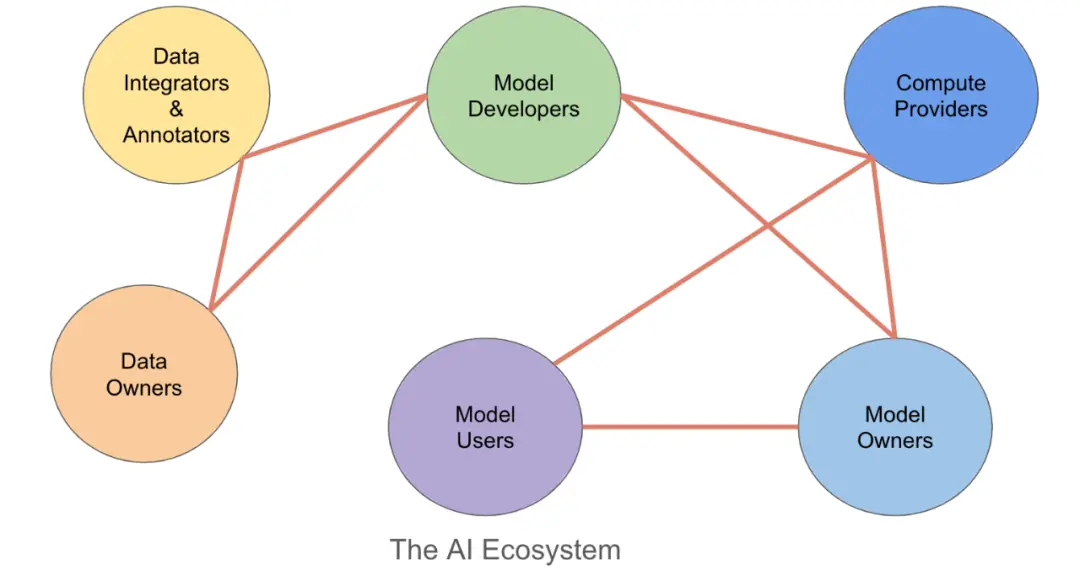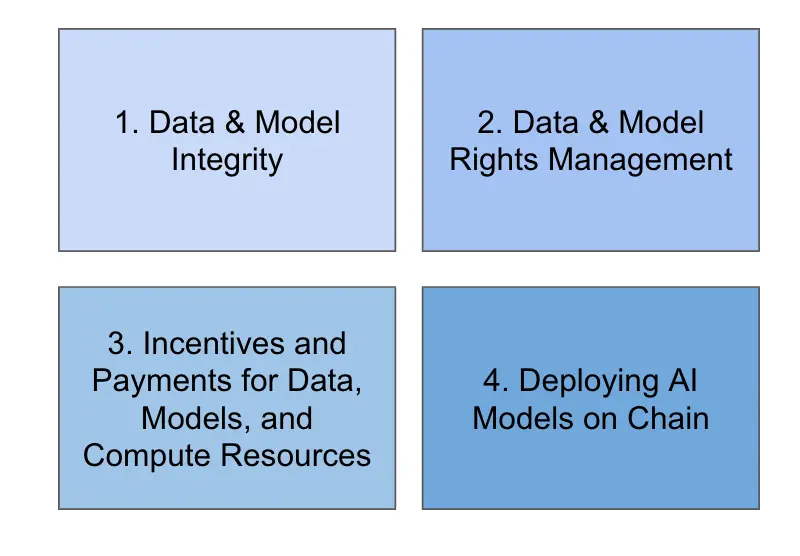Coinbase: Investment and Entrepreneurship Opportunities in AI Blockchain
- WBOYWBOYWBOYWBOYWBOYWBOYWBOYWBOYWBOYWBOYWBOYWBOYWBforward
- 2024-03-11 10:01:09893browse
Original title: "Blockchain for AI"
## Author: Rajarshi Gupta, Vijay Dialani
Over the past year, we have witnessed an explosion in the capabilities and applications of artificial intelligence. This includes significant improvements in the sophistication of text-to-image models, large language models, and their use in many business use cases such as search and recommendations, facilitating software development, and big data analytics. It is predicted that generative AI alone will form a $1.3 trillion market by 2032, with a compound annual growth rate (CAGR) of 42% over the next decade. When studying the intersection of blockchain and artificial intelligence, there are two main aspects to focus on. The first is the use of artificial intelligence/machine learning models and methods to enhance the transaction process of blockchain platforms, decentralized applications and digital assets. Secondly, focus on how to use blockchain technology to create value for developers and users of artificial intelligence/machine learning products and services. This cross-fertilization brings new possibilities to both fields, promoting innovation and progress. Fundamentals of Blockchain CapabilitiesBlockchain technology has a variety of basic capabilities that can be used to develop, deploy, and run artificial intelligence models. These capabilities include cryptographic primitives, blockchain protocols, and smart contracts. These properties are closely related to AI applications and we will explore them in detail in the following sections.Data Security: Helps AI store data in a tamper-proof and immutable manner and achieve high performance by using decentralized servers that are not vulnerable to attack, manipulation, censorship, and denial of service Availability.
Data testability, traceability, and auditability: Record transactions and assets in an immutable and transparent manner, making it easy to track the source, ownership, provenance of data, and data with numbers Signed and timestamped protocol. This also provides auditability and verifiable capabilities.
Decentralized decision-making: Enables decisions to be made by multiple entities or directly between two parties without a pre-existing trust relationship between them or with a central entity Make decisions.
Autonomous and transparent code execution: Enable programs to execute as smart contracts that are transparent to all parties involved and do not require reliance on trusted and centralized intermediaries It can run autonomously.
Decentralized Identity: Provides a secure digital identity mechanism that allows users to interact with services without revealing privacy.
Micro payment: Provide a safe and lightweight payment method to reduce friction in the payment process.
1. How blockchain can benefit artificial intelligence

NFT will allow users or developers to maintain their ownership rights and further transfer ownership of the corresponding digital assets to others. It is also possible to envision a blockchain-based data and model access control mechanism, such as smart contracts that allow/restrict access based on a given list of user addresses. Alternatively, it could be integrated with a decentralized identity solution (perhaps using state-of-the-art cryptography such as zero-knowledge proofs) to allow access based on certain proven properties (e.g. allowing access based on proof that the user is old enough or only accessible from certain geographic locations) while protecting user privacy.
2.3. Incentives and payments for data, models, and computing resources
Blockchains can use stablecoins to facilitate low-rate micropayments using generative AI models. Smart contracts can allow revenue to be shared among multiple co-owners of a model in a decentralized manner. This co-ownership model is actually a “decentralized Hugging Face” that may allow small and medium-sized model developers to join forces and compete with the larger companies in the field. It can also be used to incentivize data providers, data annotators, model developers or human feedback providers around the world to join a new decentralized project to develop new generative AI models or solutions, and at the same time, have appropriate Mechanism to track contributions so that incentives can be distributed equitably.
Blockchain can also be used to create a decentralized data/model/computation market, enabling calculation providers, training data providers, model developers and users to easily search and match each other, providing incentives , payment and signing of contracts and agreements. A decentralized blockchain-based review system implemented using smart contracts can incorporate automated and human-based reviewers into the same system to incentivize high-throughput, thorough, high-quality review of data and models.
2.4. Deploying AI on-chain
This category involves running certain AI models directly on the blockchain for greater transparency and trust. AI models may provide some inference or generation use cases directly to end users, giving them confidence that only the model they intend to provide input to can receive said input and produce the output they see without any manipulation, falsification or censorship. Alternatively, AI models can be deployed to help smart contracts adjust and optimize their own parameters in response to user transactions.
The AI model may also be a smart contract that uses historical and current transaction data on the chain to make buy/sell/trade decisions on digital assets for profit. These models can be deployed on Layer1 chains as smart contracts or through Layer2 systems such as zk-rollups. These models may be privately owned or decentralized in the form of a DAO, allowing multiple individuals and entities to own a “stake” in a given on-chain model.
In the long term, for such applications, there may be interest in researching and developing a completely new platform to support AI workflows, given the high data and computing requirements of AI applications.
3. How to Help
Coinbase’s mission is to empower more than 1 billion people with economic freedom. As Crypto usage grows, we are focused on building the most trustworthy, compliant products and services and supporting other builders. It’s clear that AI blockchain fits the strategy of enabling those individuals and organizations that are part of the emerging AI ecosystem (which is currently almost entirely based on the centralized and less transparent Web2 framework) to benefit from blockchain and AI-based Benefiting from chain-based Crypto solutions, this is broadly defined.
We believe Coinbase is particularly well-suited to become a major contributor in this space because, a) it has significant visibility and brand power among both retail customers and institutional users of those blockchain assets and services; b) ) it has a proven track record of success in helping bridge the gap between the emerging Web3 world and existing Web2 systems; c) it has a team with an understanding of the growing generative AI ecosystem and the needs of developers and other stakeholders Deep understanding and strong ML development team.
Coinbase is deeply interested in exploring partnerships and integrations with like-minded companies, such as those with expertise in artificial intelligence solutions and ecosystem services, and are committed to turning ideas into reality.
The above is the detailed content of Coinbase: Investment and Entrepreneurship Opportunities in AI Blockchain. For more information, please follow other related articles on the PHP Chinese website!
Related articles
See more- HTML5 geographical positioning Geolocation-API and Haversine geospatial distance algorithm (graphics and text)
- Blockchain technology in PHP
- Covalent Network (CQT) establishes cooperation with the University of Calgary to jointly promote blockchain technology innovation
- Coinbase reported revenue that exceeded expectations, and its stock price soared 14%! Blockchain concept stocks rose simultaneously
- Coinbase has experienced two zero balance errors in the past five days

